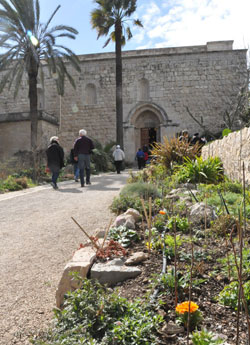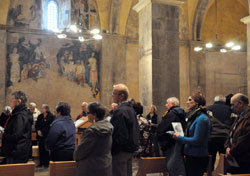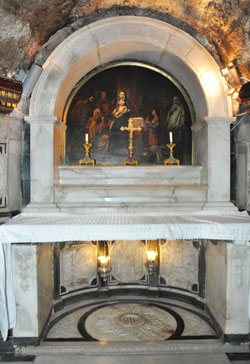By Natalie Hoefer
ABU GOSH and EIN KAREM—Ghostly, faceless figures adorned the stone walls of the 12th century Church of the Resurrection in Abu Gosh, called Emmaus in Jesus’ time. The faces were wiped away by Muslims centuries before.
The towering walls echoed with Archbishop Joseph W. Tobin’s voice as he delivered a homily on the Emmaus story in Luke 24.
“I believe it is not a coincidence that we’re here, listening to that Gospel on the second to last full day of our pilgrimage,” he said. “I don’t think it would have had the same impact on us if we’d heard it on the first day.” (See a photo gallery from the pilgrims' day)
He spoke of the parallel between the disciples’ journey to Emmaus and that of the members of the archdiocesan pilgrimage to the Holy Land. The archbishop noted how Jesus first broke open the Scripture for the disheartened disciples on their journey to Emmaus from Jerusalem, and how “it all came together for them in the breaking of the bread.”
The 12th century church was built by Crusaders on top of the remains of several destroyed Christian churches dating back to the 3rd century. The church is built over water flowing from a nearby spring. Tradition holds that Jesus and the disciples would have washed their feet in the stream before eating their supper.
The highlight of the day for Mike and Audrey Kostrzewa of SS. Peter and Paul Cathedral in Indianapolis occurred during the Mass in the church.
“We got to renew our vows like the others did in Cana,” said Mike. “We weren’t able to do it that day, so we did it today in Emmaus. That was really special.” The couple has been married for almost 42 years.
“The setting was perfect,” said Audrey, who felt “honored” to serve as cantor during the Mass. “It was a gorgeous church—it was a privilege to be there.”
The couple joined several other pilgrims on what Mike called “quite a hike” up to the Church of the Visitation in Ein Karem, the town where Mary visited her cousin Elizabeth upon hearing the older woman was expecting. It lies high on a mountainside about 4.5 miles west of Jerusalem.
Tony Azraq, the pilgrimage tour guide who is an archaeologist and professor, said the site is traditional rather than authentic. A Benedictine monastery and convent are located on the site.
The Magnificat—the prayer the Blessed Mother exclaimed upon Elizabeth’s greeting—is written in tiles in several languages on the walls of the church’s courtyard.
The pilgrims also walked through a light rain to the nearby church marking the traditional birthplace of St. John the Baptist. In the grotto of a cave below and to the side of the main altar, several pilgrims knelt to touch the place where it is believed the son of Elizabeth and Zechariah was born.
Joann Pierotti of Sacred Heart Parish in Wanatah, Ind., in the Diocese of Gary, was impressed by all the churches the pilgrims visited today.
“Today was all so inspiring,” she said. “Most inspiring was just going into the churches, sitting and meditating. They’re all so beautiful . I’m so thankful I was able to come.”
Pierotti heard about the pilgrimage through a friend. It was her first time to the Holy Land, and her first time to meet and spend time with Archbishop Tobin.
“His homilies are just amazing,” she said. “You try to catch every word and hang on. He connected his homily of the day with our travels of that day, and pulled it together so beautifully.”
“And he’s such a down-to-earth man. You feel comfortable with him. He’s just one of the group. You didn’t feel he put himself above anyone else.”
Despite living in the Diocese of Gary in northwestern Indiana, Pierotti believes she will see Archbishop Tobin in the future—“wearing red.”
“I think he’ll be a cardinal in the not too distant future,” she said. “I think he was born for it.”
See a photo gallery from Day Ten of the pilgrimage



No comments:
Post a Comment